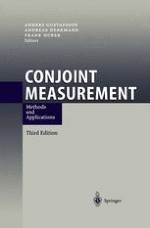2003 | OriginalPaper | Chapter
Conjoint Choice Experiments: General Characteristics and Alternative Model Specifications
Authors : Rinus Haaijer, Michel Wedel
Published in: Conjoint Measurement
Publisher: Springer Berlin Heidelberg
Included in: Professional Book Archive
Activate our intelligent search to find suitable subject content or patents.
Select sections of text to find matching patents with Artificial Intelligence. powered by
Select sections of text to find additional relevant content using AI-assisted search. powered by
Conjoint choice experimentation involves the design of product profiles on the basis of product attributes specified at certain levels, and requires respondents to repeatedly choose one alternative from different sets of profiles offered to them, instead of ranking or rating all profiles, as is usually done in various forms of classic metric conjoint studies. The Multinomial Logit (MNL) model has been the most frequently used model to analyze the 0/1 choice data arising from such conjoint choice experiments (e.g., Louviere and Woodworth 1983; Elrod, Louviere and Davey 1992). One of the first articles describing the potential advantages of a choice approach for conjoint analysis was by Madanski (1980). His conclusion was that conjoint analysts could adopt the random utility model approach to explain gross trends or predilections in decisions instead of each person’s specific decision in each choice presented. The real breakthrough for conjoint choice came with the Louviere and Woodworth (1983) article in which they integrated the conjoint and discrete choice approaches.
